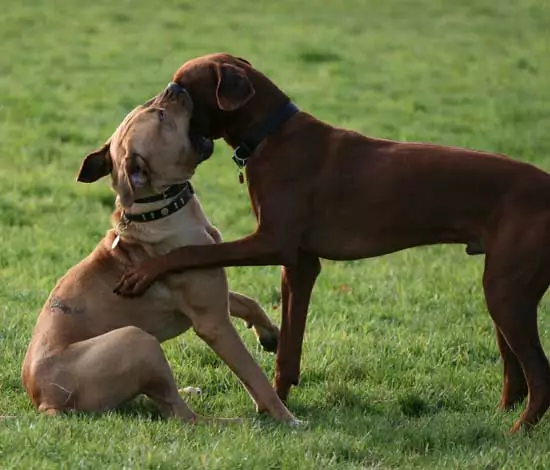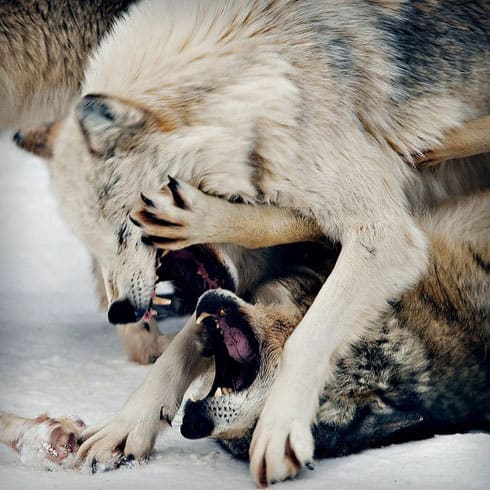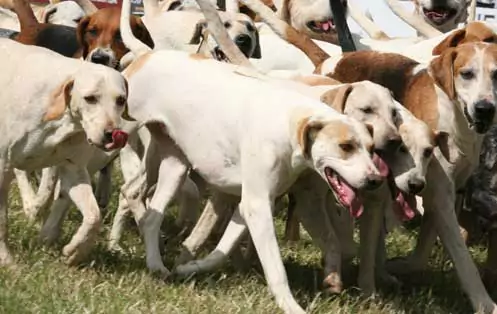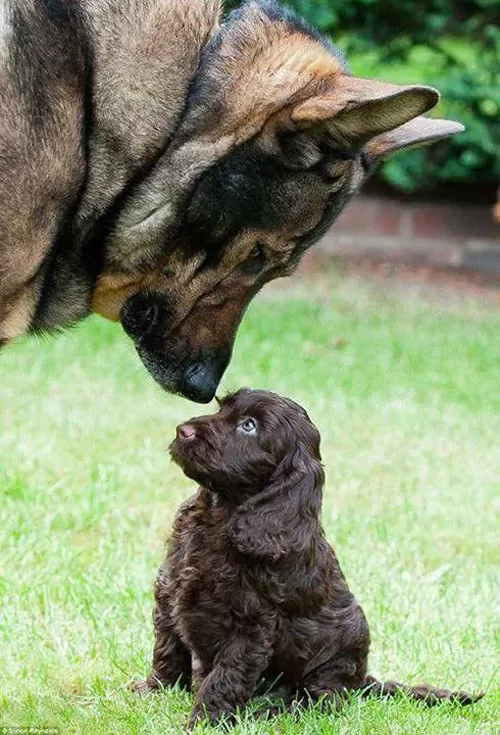Dogs and Dominant Behaviour
Dominance and Dog Behaviour

Surely there has always been a conflict where dominance and subjugation have existed.
Strangely enough, dominance is a relatively new concept in biology.
It was first mooted early last century by the Norwegian researcher Thorleif Schjelderup-Ebbe who coined the term “pecking order”. Following his studies on chickens.
The simple premise was that chicken A can peck all the other chickens, but chicken Y can only peck X. and poor old X is definitely bottom of the heap.
In the 1930s, other researchers coined the term “alpha male” and its converse, the “beta male”.
This was intended to describe the leaders of a wolf pack the dominant males or females, the beta’s being the lower ranked animals.
Biologists have never come close to agreeing on what dominance actually means. Therefore until an in-depth study is carried out, and the word Dominance is accurately defined, it will remain as just conjecture and theory. This leads me neatly onto recent books and the latest theoretical ideas.
As trainers and behaviourists, we have a habit of latching onto the latest buzz theorems. The latest ideas and study, and then to postulate that these theories are actual scientific facts.Which the very word “Theory” discounts. Theory means just that, and all that can be said is that it is speculative.

it’s all just a figment of our fevered imagination.
They now state that dogs cannot and do not strive for dominance because they are conspecific
The term conspecific they can only pack up with their own kind. I totally agree that they are conspecific
And because of that, they cannot perceive humans as a dog or an Alpha.
In reality, the theorists who follow this argument should look up the word “conspecific” they will see it has been hijacked “an organism belonging to the same species as another organism”.
Where in that explanation does it say that animals cannot view other animals in a dominant or bullying way?
It is a bald statement, not open to conjecture. In reality, it means,”belonging to the same species”. You cannot hypothesise more from that as it would then be only speculative guesswork. Don’t get me wrong I do not believe that dogs imagine we are dogs and that we can be the Alpha of our own little pack. We can’t, I explain this in my article (1) The Alpha Myth
This is from www.reference.com an online encyclopaedia: “Dominance in the context of biology and anthropology is the state of having high social status relative to other individuals, who react submissively to dominant individuals. The opposite of dominance is submissiveness. Dominance hierarchies are found in many animals, including primates such as human beings”.
If we accept the antonym of dominance is submission, and that many dogs demonstrate clear submissive behaviour to humans as well as other dogs. Then how can we suggest that dogs cannot demonstrate dominance or dominant behaviour?
There is a word in music “enharmonic” that means changing the name without altering the pitch. In other words, two separate notations stand for the same sound. For example, the enharmonic word for F-sharp is G-flat. Both are exactly the same note but are named differently. I believe that is what is happening with the word dominance.
Patricia McConnell PhD the author of an excellent book “The Other End of The Leash” states.“In some training and behavioural circles, all talk of dominance is classed as politically incorrect, and that these people are ardently opposed to anyone using the word in the context of dogs.”
She goes on to say, that at a professional seminar the word became so loaded that Wayne Hunthausen and herself started to call it “the concept formerly referred to as dominance” complete with its own Prince type icon. How we can dismiss the fact that both dogs and ourselves are derived from animals that live in a controlled and carefully organised social system, and that within that system there are leaders and there are followers.

I will accept that dogs do not pack up to live and hunt the same as wolves.
They lost that requirement when they filled an ecological niche and predated off the detritus of mankind.
Becoming domesticated in the process. see my article on (2) The Origin of The Dog.
That is not to say they do not enjoy the social meeting and greeting with others of their own kind, and in that social coming together, there are clear indications of status and rank.
I have five dogs at present, they have distinct personalities and clear pecking orders within their own little pack.
I am also to some extent included in that pack but not as an Alpha that would be impossible. I make sure that I control the situation by laying down guidelines and rules and I control resources; does that make me dominant or submissive or neither to my dogs?
Donna Brander BSc(Hons), Honorary Fellow(R(D)SVS) states: “One of the most important issues to a dog is the stability of the pack. Without leadership, the stability of the pack is threatened.”
It is also of great benefit to be the leader. The leader gets to eat first, has the best places to sleep, has reproductive privileges and, in general, has all the best “stuff”. The leadership status is not a gender issue. Both males and females can and do achieve high status within the pack”.
I find some of that statement to be flawed. Scientist’s, behaviourists, and research biologists are now questioning the validity of the pack rule theory in two main areas. First, because it does not appear to occur in the wild. The strong dominance hierarchy that has been often been described for wild canids such as Wolves, Dingoes and Wild dogs suggests that social behaviour in wild canids may be a product of environmental circumstances rather than any form of instinctual behaviour.
Secondly, because feral dogs do not appear to exhibit the classic wolf-pack structure, especially in remote areas. Once again Patricia McConnell in her book “the other end of the leash” says:. “Recently there’s been some confusion in the world of dog training about the role that status and hierarchy have in dog behaviour. Some people argue that wolf-like pack hierarchies have no relevance to dogs because our house dogs probably derived from scavenging village dogs who didn’t live in packs like wolves”“

Some trainers argue that social status and hierarchy are irrelevant to our own pet dogs.
But that seems counterintuitive, given what we know about how our own dogs behave and lacks understanding of how behaviour and the environment interact”
That begs the question do domestic dogs pack up like their wild cousins?
We certainly see Fox Hounds that are far more suited to pack life than as individual animals.
Beagles to some extent fall into this category as do Otterhounds and Harriers. But are they packing up for the joy of the chase, rather than the need to survive and procreate?
Raymond and Lorna Coppinger in their excellent book (Dogs A New Understanding of Canine Origin, Behaviour and Evolution) believe that the domestic dog is very different from its wild cousins.
In their studies and observations on the island of Pemba, (a lush tropical island in the Indian Ocean). They observed that the village dogs did not pack. In fact, they tended to avoid each other except for small family units.
On that basis and study alone it has been suggested that domestic dogs do not form a pack with their own kind, and certainly do not do so with humans. I would certainly agree with that last statement.
Personally, I do not believe we as humans can be Alphas or pack leaders. Having said that it does not compute that we do not observe pushy and dominant dogs in our homes.
Coppingers theories are interesting, informative and enlightening.

Therefore, as modern-day dog probably derived from village dogs that are seen on Pemba
, Then the idea of a hierarchical system does not exist as it does in wild canid’s that hunt as a pack.
I believe this theory has some fundamental flaws.
On the dump at Chake Chake, where these village dogs had better resources, hierarchical and resource disputes broke out far more often,
Dominance, status, and rank allowed the top dogs to get the richest pickings. I believe that is where this theory starts to show some anomalies and shortcomings.
Another anomaly is that these feral dogs were not part of family life with humans. They were not owned by individuals, as we own dogs. They slept outside and predated on man’s detritus, they were not fed by the village people or looked after by any family or group.
We have a far closer relationship with our dogs than the Pemban ever has or probably ever will. That is not to say that the book was not excellent, I thoroughly enjoyed it. I believe it to be very important for anyone who owns a dog or is studying dog behaviour. It has many valid theories and observations. Having said that It does not follow that I have to agree with all of Coppinger’s assumptions and beliefs.
Barry Eaton has also written a very interesting book called Dominance “Fact or Fiction” which is very readable and makes some interesting points but unfortunately, his summation is incorrect when related to“Dominance” “Rank” or “Status”.
When a piece professing evidence that dispelled the myth of canine dominance appeared on Psychology Today, ethologist Marc Bekoff intervened saying “Wolves (and other animals, including humans), display social dominance, it just isn’t always easy to boil dominant behaviour down to simple explanations. Dominant behaviour and dominance relationships can be highly situational, and can vary greatly from individual to individual even within the same species.”

I am more than aware that the word dominance is used to explain almost every behavioural problem in our pets, and that includes aggression.
Yet in reality, the dominant dog has no need for aggression. An air of authority and quiet confidence emanates from this type of dog.
Whereas the submissive fearful dogs are more likely to show signs of aggression and to bite.
To some extent I sympathise with those, claiming the word dominance should no longer be used, that it is defunct, outdated, and irrelevant.
But sympathising doesn’t mean that I agree with these theories or logic.
Advances in our learning and scientific studies have shown that our previous knowledge base did not give us the full picture.
Most of these theories were based on studies that were at best incomplete, and at worst totally incorrect.
The new wave of positive reinforcement style training and behavioural modification is proving to be far more effective and kinder than the methods previously used.
However, it is impossible to train using just Positive Reinforcement. Just holding the dog back on a lead is negative punishment. See (3) Killing with Kindness
The advent of clicker training has proved a revelation to many of today’s obedience and behavioural trainers. The style of training that insisted the dog should always be subservient, and that reward or treat based training is bribery, is fortunately now dying out. Though there are still places, individuals organisations that believe it is the only way to train.
I believe a dog should know its place, and it is up to us to teach that. Ignoring bad behaviour and only rewarding the good only covers half of the problem. Putting yourself in control by controlling resources is not brutal or aggressive it is common sense. This is why I designed and developed (4) The Jingler which allows you to tell the dog when it has done something wrong and at that moment. Whilst the “clicker” or the word “good” tells it when it has done something right.
To allow political correctness to creep into dog behaviour or training is counterproductive. Let’s be realistic and look at what we have in front of us, sometimes a joy, other times pushy and dare I say “dominant” Irrespective of what we have, we love them all even their strange and irritating idiosyncrasies. I personally would find it very difficult living without them.
Stan Rawlinson
Monday, 20 March 2006. Updated July 2018
(1) The Alpha Myth
(4) The Jingler
(6) The Dog Store
Quotes and mentions:
Donna Brander BSc(Hons), Honorary Fellow(R(D)SVS
Patricia McConnell- The other end of the leash
Coppingers- Dogs A New Understanding of Canine Origin, Behaviour and Evolution
Barry Eaton. Dominance Fact or Fiction







